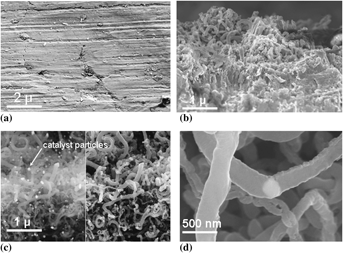Crossref Citations
This article has been cited by the following publications. This list is generated based on data provided by
Crossref.
Gaikwad, Anil V.
Rout, Tapan K.
Van der Plas, Dirk
Dennis, Robert V.
Banerjee, Sarbajit
Pacheco Benito, Sergio
and
Lefferts, Leon
2012.
Carbon nanotube/carbon nanofiber growth from industrial by-product gases on low- and high-alloy steels.
Carbon,
Vol. 50,
Issue. 12,
p.
4722.
Velazquez, By Jesus M.
Baskaran, Sivapalan
Gaikwad, Anil V.
Ngo-Duc, Tam-Triet
He, Xiangtong
Oye, Michael M.
Meyyappan, M.
Rout, Tapan K.
Fu, John Y.
and
Banerjee, Sarbajit
2013.
Effective Piezoelectric Response of Substrate-Integrated ZnO Nanowire Array Devices on Galvanized Steel.
ACS Applied Materials & Interfaces,
Vol. 5,
Issue. 21,
p.
10650.
Patil, Vikas
Dennis, Robert V.
Rout, Tapan K.
Banerjee, Sarbajit
and
Yadav, Ganapati D.
2014.
Graphene oxide and functionalized multi walled carbon nanotubes as epoxy curing agents: a novel synthetic approach to nanocomposites containing active nanostructured fillers.
RSC Adv.,
Vol. 4,
Issue. 90,
p.
49264.
Dennis, Robert V.
Viyannalage, Lasantha T.
Aldinger, Jeffrey P.
Rout, Tapan K.
and
Banerjee, Sarbajit
2014.
Nanostructured Magnesium Composite Coatings for Corrosion Protection of Low-Alloy Steels.
Industrial & Engineering Chemistry Research,
Vol. 53,
Issue. 49,
p.
18873.
Dennis, Robert V
Patil, Vikas
Andrews, Justin L
Aldinger, Jeffrey P
Yadav, Ganapati D
and
Banerjee, Sarbajit
2015.
Hybrid nanostructured coatings for corrosion protection of base metals: a sustainability perspective.
Materials Research Express,
Vol. 2,
Issue. 3,
p.
032001.
TabkhPaz, Majid
Park, Dong-Yeob
Lee, Patrick C
Hugo, Ron
and
Park, Simon S
2018.
Development of nanocomposite coatings with improved mechanical, thermal, and corrosion protection properties.
Journal of Composite Materials,
Vol. 52,
Issue. 8,
p.
1045.
Gergely, András
2018.
A review on corrosion protection with single-layer, multilayer, and composites of graphene.
Corrosion Reviews,
Vol. 36,
Issue. 2,
p.
155.
Banerjee, Debika
Guo, Xiaohang
Benavides, Jaime
Rameau, Bruno
and
Cloutier, Sylvain G
2020.
Designing green self-healing anticorrosion conductive smart coating for metal protection.
Smart Materials and Structures,
Vol. 29,
Issue. 10,
p.
105027.
Radhamani, AV
Lau, Hon Chung
and
Ramakrishna, S
2020.
Nanocomposite coatings on steel for enhancing the corrosion resistance: A review.
Journal of Composite Materials,
Vol. 54,
Issue. 5,
p.
681.
Wen, Cai
2023.
A Study on the Value of Green, Low Carbon and Environmentally Friendly Materials in Modern Gardens.
Journal of Biobased Materials and Bioenergy,
Vol. 17,
Issue. 4,
p.
433.
Sill, Tiffany E.
Cantrell, Joseph K.
Ponce, Victor
Valdes, Caroline G.
Fletcher, Torrick
Fuller, Kerry
Singh, Sujata
Al-Hashimi, Mohammed
Castaneda, Homero
Johnson, Peter M.
and
Banerjee, Sarbajit
2025.
Deciphering and Mitigating Failure Mechanisms in Poly(ether Imide) Corrosion Protection Coatings for Automotive Light-Weighting.
ACS Engineering Au,
